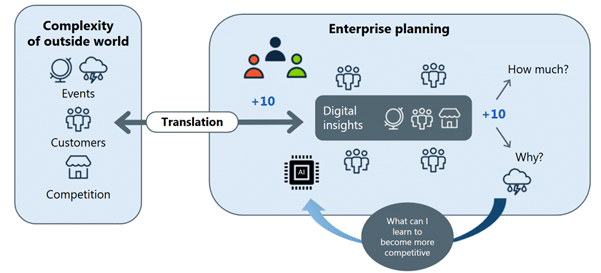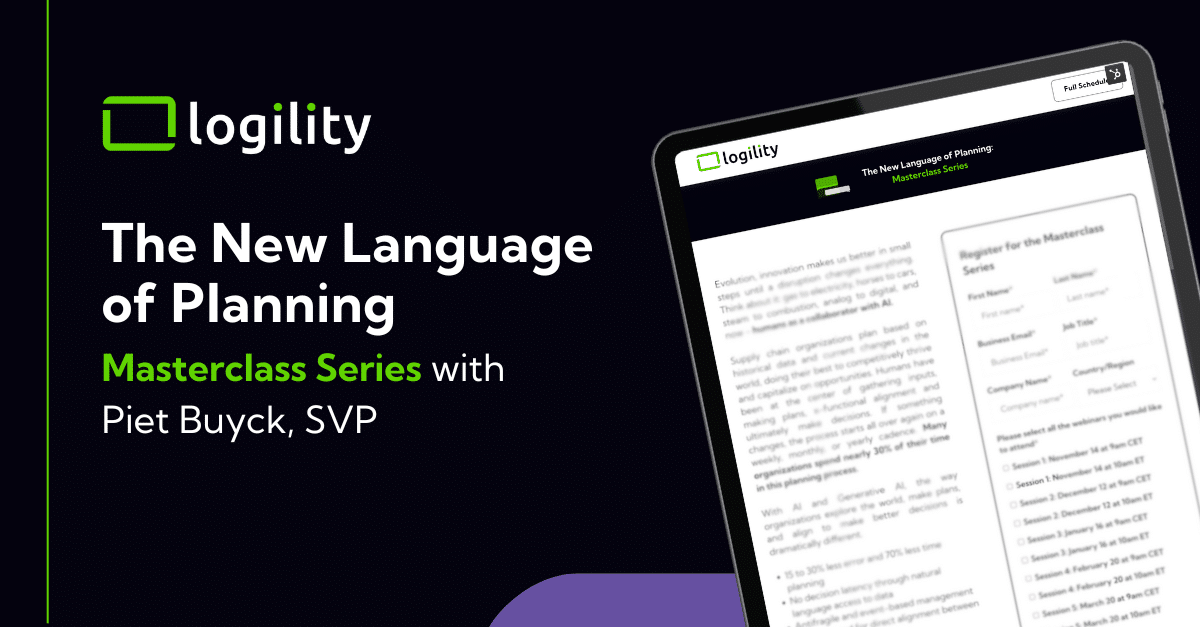Balancing forecast accuracy with inventory management gets more challenging every day. Traditional approaches often divide departments like sales, marketing, and production. This makes it hard to reach agreement. It can also lead to missed opportunities and conflicting priorities.
Fortunately, this is starting to change. Artificial intelligence (AI) and rapidly developing generative AI tools provide complex, real-time, and in-depth insights specific to supply chain management. Further, AI-driven demand sensing allows businesses to combine scattered data which is essential for better forecast accuracy.
“People are used to interacting with data in a complex way—not just for scheduling but to get real, in-depth answers. This is particularly critical in supply chain environments where aligning data across siloed departments is essential.” –Piet Buyck, SVP Solution Principal, Logility
Moving from What Happened to What is Coming
In the past, supply chain planners relied on multiple forecasting methods tailored to different products or phases of the product lifecycle. These methods leveraged available historical data and market knowledge while blending the best features of various models to maintain peak accuracy. This approach required agility, as planners regularly shifted methods and models to address changing conditions.
The focus is now moving from the quantity of forecasting models to their effective application. New demand models like ensemble modeling, driver-based forecasting, and demand sensing create explainable forecasts.
These approaches help companies improve short-term, mid-term, and long-term planning. They also help planners identify and understand unusual patterns. By leveraging these advancements, organizations can enhance their systems’ ability to learn and adapt.
A New Era of Demand Planning White Paper
Learn more about these new demand models in this whitepaper.
Download Now
AI Solutions for Complex Demand Planning
For supply chain professionals, managing demand involves analyzing multiple signals from diverse sources. Traditional statistical models often struggle to capture the nuances of order patterns or the context behind large orders.
To close this gap, demand sensing utilizes AI to analyze and interpret data across three critical levels:
Macroeconomic trends: Factors such as inflation or regulatory changes influence long-term demand.
Customer behavior: Real-time insights into customer orders, inventory levels, and distribution channels clarify short-term demand.
Operational events: Price shifts, competitor actions, and promotions shape medium-term demand.

Figure: AI offers a new way for supply chain management
As an example, demand sensing is particularly advantageous for industries like life sciences. It helps understand signals such as hospital or patient consumption trends, while taking strict regulations into account. By translating raw data into actionable insights, planners gain the agility and accurate knowledge necessary to anticipate stock levels, mitigate stockouts, and optimize inventory.
AI advancements in demand sensing bring several benefits, including:
Validated forecasts: Instead of replacing consensus forecasts, demand sensing confirms and refines them using downstream data. This reduces error rates and creates actionable insights for short-term decision-making.
Enhanced responsiveness: With frequent updates, such as weekly granular forecasts, businesses can respond swiftly to shifts in customer demand or market conditions.
Streamlined operations: Automated demand sensing, which uses AI to interpret and respond to demand signals automatically, enables better alignment across departments, reducing reliance on error-prone manual processes and improving efficiency.
Increased confidence: By offering explainable forecasts, demand sensing fosters trust among stakeholders and ensures confidence in supply chain projections.
Piet Buyck emphasizes that AI is particularly valuable in decoding the “voice of the customer.” Demand sensing connects customer orders, stock levels, and distribution data back to your planning process. It’s about understanding what’s happening now and predicting what’s next so your supply chain can respond more effectively.
Demand Sensing with AI Roadmap
To fully realize the benefits of demand sensing, companies must take a strategic approach to implementation. This involves adopting the right tools and refining how these tools are used to support dynamic business needs.
Key steps include:
Integrate AI Solutions Thoughtfully: Choose AI tools that align with industry needs, such as frequent updates for perishable goods or tailored insights for long-cycle products. Piet Buyck notes, “Demand sensing connects customer orders, stock levels, and distribution data back to your planning process.”
Distinguish and Apply Signals Effectively: Macroeconomic trends are good for baseline forecasts. Short-term signals, like customer orders or inventory levels, work better for weekly demand-sensing. Ensuring these insights are used at the right time prevents the system from losing its predictive power due to misaligned data.
Break Down Silos: Historically, functional silos have dominated supply chain management, with sales, marketing, and operations often taking disconnected approaches to demand planning. AI-powered demand sensing offers the opportunity to unify these perspectives by creating a single source of truth that provides consensus forecasts and explains the reasons behind them.
Use Predictive Analytics: Use AI tools in the supply chain to help planners predict short-term changes more accurately. Doing so allows supply chain teams to adapt to fluctuations caused by promotional events, market shifts, or customer order surges. Buyck explains, “Demand sensing doesn’t just refine forecasts—it validates them.”
Optimize Frozen Periods: Identify areas in the supply chain, such as packaging and distribution, that can benefit from short-term adjustments. Understanding these constraints allows organizations to maximize the utility of demand sensing without disrupting established processes.
Automate Exception Management: Use demand sensing to identify anomalies and trigger alerts for immediate action, helping planners recalibrate quickly to avoid disruptions.
A New Level of Supply Chain Agility Emerges
As supply chain complexity grows, the adoption of AI-driven demand sensing becomes a necessity rather than a luxury. By embracing AI-driven demand sensing, companies can move beyond the limitations of fragmented, traditional approaches and unlock the full potential of their supply chains.
“Planning is not just a supply chain function,” Buyck concludes. “It’s a function of the entire organization. By better understanding the voice of the customer, businesses can align more effectively and reach their key performance improvements with greater agility.”
For demand planners and supply chain managers, AI marks the dawn of a new era—one that empowers them with the confidence and control needed to overcome the complexities of modern supply chains.

The New Language of Planning Masterclass is Underway!
Piet Buyck, SVP Innovation at Logility continues with an in-depth series called The New Language of Planning Masterclass. Sign up for upcoming sessions here.
Sign up today!




















